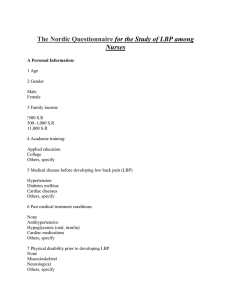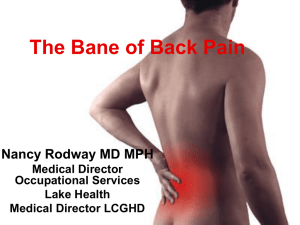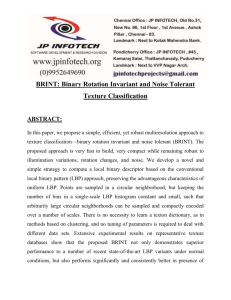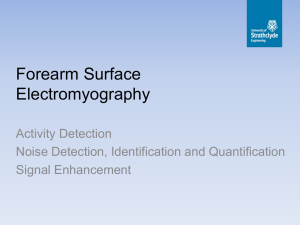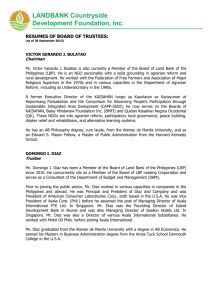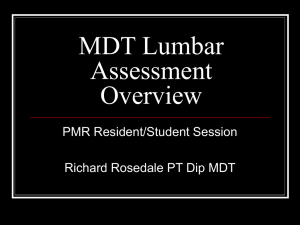Pregnancy-Related Low Back Pain
advertisement
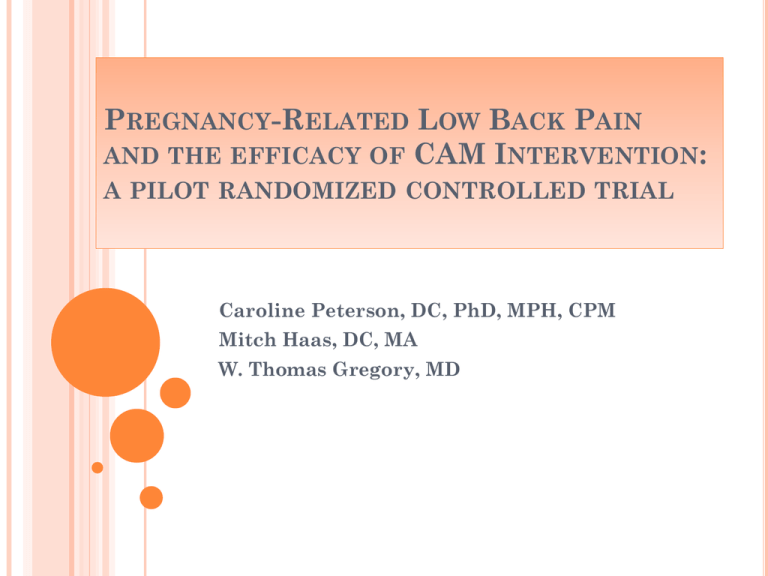
PREGNANCY-RELATED LOW BACK PAIN AND THE EFFICACY OF CAM INTERVENTION: A PILOT RANDOMIZED CONTROLLED TRIAL Caroline Peterson, DC, PhD, MPH, CPM Mitch Haas, DC, MA W. Thomas Gregory, MD PREGNANCY-RELATED LOW BACK PAIN EPIDEMIOLOGY Insidious onset during pregnancy > 50% all pregnancies1,2 Intensity and frequency increases3 Only consistent predictor: Hx LBP 68% LBP unreported1 25% of those reporting LBP are treated1 2/3 require sick leave due to LBP4 1/3 untreated LBP continues 1 year postpartum1,5,6 at increased risk of comorbidities7 PILOT RANDOMIZED CONTROLLED TRIAL Participants Healthy 20-49 years old Pregnant with singleton LBP of insidious onset during pregnancy Comparison groups Exercise Spinal manipulation Neuro-emotional technique Enter study at any point in pregnancy Study visits parallel prenatal visits SAMPLE CHARACTERISTICS (N=57) MEAN OR FREQUENCY 29.7 years old (5.0 SD), range 20-40 77% White non-Hispanic 66% at least 4 year college degree 72% married 77% work outside home during pregnancy 3 times pregnant (1.9 SD), range 1-9 1 times given birth (1.1 SD), 0-5 25.4 wks entered study (6.4 SD), range 10-37 SAMPLE HISTORY OF LOW BACK PAIN MEAN OR FREQUENCY 54% history of low back pain prior to pregnancy 25.4 weeks gestation LBP began, range 2-28 12.3% taking medication for LBP at study start 25% took time off work due to LBP 27.9 BMI at study entry, range 21-35 93% health very or quite good prior to pregnancy 61% at least weekly exercise prior to pregnancy Location LBP: Lumbosacral (50.9%), Pelvis (21%), Lumbar (14%), Composite (10.5%) SPECIFIC AIM #1 Determine the Feasibility of the Study Can 90 pregnant women be recruited within 12 months? Can participants comply with exercise expectation and treatment schedule? Can a completion rate of 90% be achieved? What is the average cost per participant? Does a qualitative component to the study further explain PRLBP? CAN 90 PREGNANT WOMEN BE RECRUITED WITHIN 12 MONTHS? Assessed for eligibility n=138 Excluded n=81 Randomized n=57 Discontinued prior to 37 weeks n=12 Exercise n=7 (32%) NET n=2 (10%) SMT n=3 (20%) Sample analyzed n=57 Exercise n=22 (n=16, 2+ data points) NET n=20 (n=19, 2+ datapoints) SMT n=15 (n=15, 2+ datapoints) Can a completion rate of 90% be achieved? No: 80% achieved Stated Reasons for Attrition Swine Flu n=2 No improvement after 1 visit n=1 Wants physical therapy n=1 Lost faith in modality n=1 Politics n=1 Too busy n=1 MVA n=1 Too far n=1 Friend died n=1 No show/no response n=1 Can participants comply with exercise expectation and treatment schedule? Exercise Consistent & >50% Improvement n=7 Inconsistent & >50% Improvement n=5 Consistent & <50% Improvement n=2 Inconsistent & <50% Improvement n=2 Treatment schedule To some degree What is the average cost per participant? Total cost $233/person Study visit cost $160/person Number of Study Visits 7.4 (3.14SD) Range 2-19 $20 per visit + $20 interview Recruitment costs $50/person Magazine ad $32/person Fliers, brochures, postage $18/person Lab costs $23/person SPECIFIC AIM #2 Are the study questions appropriate? 1. Does intervention alter pain intensity or disability? 2. Does pain intensity or disability influence intrauterine attachment? 3. Does pain intensity or disability influence heart rate variability? 4. Does pain intensity or disability influence labor & delivery complications? Disability = Roland Morris Disability Index Intensity = 11 point VAS Intra-uterine attachment = Prenatal Attachment Inventory ROLAND MORRIS DESCRIPTIVE STATS Group (SD) Start (SD) End % Improve % Improve 50% Exercise 10.7 (4.9) 6.1 (5.9) 38 55 NET 9.3 (3.7) 5.7 (4.7) 23 50 SMT 8.7 (4.1) 4.1 (4.3) 55 67 VAS PAIN INTENSITY DESCRIPTIVE STATS Group (SD) Start (SD) End % Improve % Improve 50% Exercise 3.9 (1.5) 2.4 (1.8) 26 55 NET 3.2 (1.4) 2.4 (1.6) 10 35 SMT 3.5 (1.1) 1.9 (1.7) 44 53 LINEAR REGRESSION MODEL Terms RM Adjusted* Mean Difference (95% CI) VAS Adjusted* Mean Difference (95% CI) Ex vs. NET 0.7 (-2.9, 4.2) 0.1 (-1.0, 1.3) Ex vs. SMT 0.01 (-3.2, 3.2) -0.3 (-1.5, 1.0) SMT vs. NET 1.2 (-2.1, 4.5) 0.5 (-0.8, 1.7) *Adjusted for gestational age at entrance into the study, outcome measure score at baseline, maternal age, and history of low back pain LABOR & DELIVERY OUTCOMES Tx Grp Ripen n (%) Induct n (%) Augmt n (%) Pain Med n (%) Mec n (%) Nuchal Cord n (%) Ex (n=13) 2 (15) 4 (30) 7 (54) 7 (54) 4 (30) 4 (30) NET (n=11) 0 0 4 (36) 3 (27) 0 2 (18) SMT (n=10) 2 (20) 4 (40) 6 (60) 3 (30) 1 (10) 2 (20) ANALYSIS NEXT STEPS Heart Rate Variability Oxytocin Attachment Prenatal Attachment Inventory Adult Attachment Interview Postpartum Mommy/Baby Video THANKS TO OUR FUNDERS! NCCAM/NIH 2T32AT0026888-06 The ONE Foundation The Tartar Foundation

